The Ruger Precision Rifle hit the market by storm in mid-2015, filling a latent demand for an affordably-priced, modern-looking precision bolt gun. Indeed, it ignited a whole new category of accurate rifles that bring the chassis gun look without the eye-watering chassis gun price tag.
As TTAG has already reviewed the RPR in .308 and in 6.5 Creedmoor, my review of the 5.56 or .223 or whatever hybrid chamber this RPR actually…but I digress. This review will be abbreviated. If you want to learn more about the excellent function and features of the RPR, check out the .308 or 6.5 CM reviews linked above.
So what is this thing? It’s officially marked “5.56 NATO” on the barrel and most of the paperwork, but it ain’t exactly that. Ruger’s website says, “5.56 NATO ‘Target’ chamber safely accommodates 5.56 NATO cartridges while providing maximum projectile control and accuracy for both 5.56 NATO and .223 Rem cartridges.” Is that a .223 Wylde? Something custom? I don’t know, but it sure can shoot.
With the superb SIG Optics TANGO6 5-30×56 scope mounted up, I proceed to shoot accuracy groups with a bipod and rear bag:
Sub-MOA all day long. Heck, I shot multiple sub-half-MOA, 5-shot groups with 77 grain Federal Gold Medal Match, and I know other shooters have had great success with the 69 grain GMM load as well. The RPR was also comfortably sub-MOA for me with 75 grain Hornady Match and 60 grain CapArms with Hornady’s V-Max projectile.
The only place it really wavered was with M855 (62 grain steel tip 5.56 NATO), where the best group I got out of it was the 1.75 MOA affair shown above. The average, though, was more like 2.5 MOA. I think it even shot a 4-inch group that day.
If you want to handload or shoot really heavy or really long bullets, go for it. The 10-round magazines have plenty of room for cartridges loaded extra long, and the barrel’s 5R rifling with a 1:7″ twist should be able to stabilize just about any 0.224″ projectile.
At the end of that 20-inch barrel is Ruger’s RPR Hybrid Muzzle Brake. Not that a 9.8-pound (before optic, bipod, etc) .223 needs much help in the recoil reduction department. Then again, there’s something to be said for a rifle so stable that you can see impacts on your target even at short ranges (i.e. 100 yards). I also didn’t find the blast or concussion of this brake to be particularly bothersome.
With the cost of .223 so low compared to most any other centerfire rifle caliber appropriate for this sort of gun and the light recoil associated with it, the 5.56/.223 Ruger Precision Rifle makes a fantastic precision trainer. For practicing the fundamentals of precision shooting and long range shooting, the RPR lets you shoot all day without bruising your shoulder or your wallet, and it has the accuracy chops to provide meaningful feedback.
Additionally, it would make a great varmint gun for taking care of pests on the ranch or for long-range coyote hunts.
If you’d rather forgo the muzzle brake, fear not, the 5.56/.223/whatever-it-is RPR ships with a thread protector as well. But wait, there’s more! Also included in the box with the two Ruger AI-pattern magazines (with dust covers) is a section of KeyMod-attach Picatinny rail, a KeyMod-attach QD sling socket, and a standard sling swivel.
There’s a heck of a lot of bolt here for .223 (or even 5.56), but it runs smoothly with its 70° throw and dual cocking cams. That makes it easy to shoot fast. A nice touch, the bolt knob is screwed on (rather than integral) and can be easily replaced with any 5/16-24 threaded, aftermarket knob.
Really, my only gripe with the RPR is the adjustment lever system on the stock. Once locked in place it was absolutely fine, but finding that sweet spot between adjustment notches after performing the actual adjusting was somewhat frustrating — they won’t lock down unless they’re over a groove rather than a land, if you will.
Other than that, in terms of customization, I suppose I’d swap the AR-15-compatible pistol grip out, throw a suppressor on its 1/2-28 threads, and call it a day. It’s a great rifle that’s incredibly accurate for a mass-produced gun. Or for any gun, really. Sub-half-minute for as low as $1,125? That’s a heck of a deal.
Specifications: Ruger Precision Rifle in 5.56/.223
Caliber: some flavor of 5.56/.223 hybrid target chamber
Capacity: 10 + 1
Trigger: Ruger Marksman Adjustable Trigger — externally adjustable pull weight from 2.25 to 5 lbs
Barrel: 20″ cold hammer forged 4140 steel with 1:7 twist 5R rifling, medium contour
Stock: folding, adjustable length of pull and comb height. Compatible with other AR-style stocks.
Length of Pull: 12″ to 15.5″
Overall Length: 39.25″ to 42.75″
Folded Length: 31.6″
Weight: 9.8 lbs
MSRP: $1,599 (available for $1,125 at 1800GunsAndAmmo)
Ratings (out of five stars):
Accuracy * * * * *
It hits the mark. Five-shot groups under a half inch maximum center-to-center spread at 100 yards shooting factory ammo from a mass-produced, barely over a thousand dollar rifle is five-star performance.
Ergonomics * * * *
I’d really fall in love with this thing if it had a shorter bolt throw, though 70 degrees isn’t in complaint territory. I do like the 45°, reversible safety selector, and everything else about the rifle is laid out very well. I like the stock, but the adjustment mechanism was a bit annoying.
Customize This * * * * *
The RPR arrives with the ability and parts to accommodate a good amount of custom configuration. With AR-style compatibility for stocks, grips, safety levers, and handguards, plus fairly easily-swapped barrels and a mess of KeyMod points, the RPR leaves the doors wide open for customization.
Reliability * * * * *
Hundreds of rounds of .223 and 5.56 straight out of the box without an issue at all. It ran smoothly and easily the entire time it was here.
Value * * * * *
The rifle represents a solid value for what it offers and so does the ammo it shoots. Yes sir, the value is here. The RPR is an ideal precision trainer, target gun, varmint gun, plinker, or even PRS-style competition gun.
Overall * * * * *
Honestly, I was never a fan of the Ruger Precision Rifle and I’m still not excited by it. It just doesn’t really “do it” for me. But that doesn’t change the fact that the RPR hits it out of the park in 5.56. Or .223 Wylde, or whatever it is. It’s an affordable, affordable-to-shoot, tack driver.




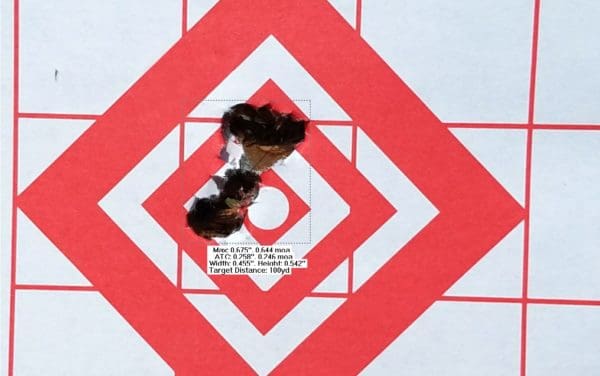
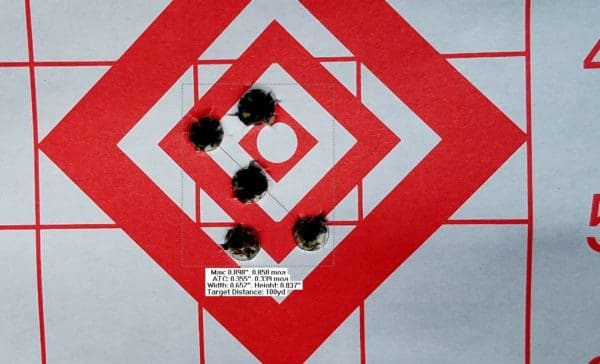

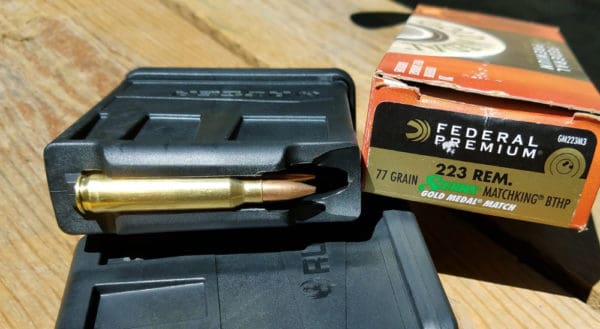


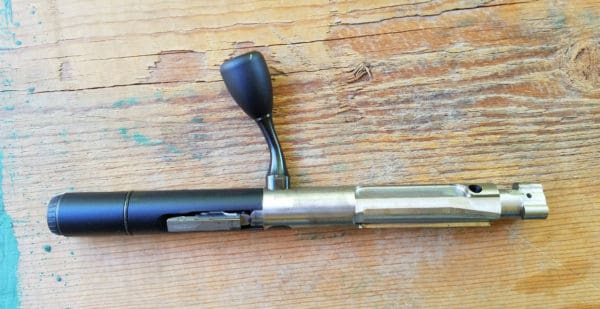
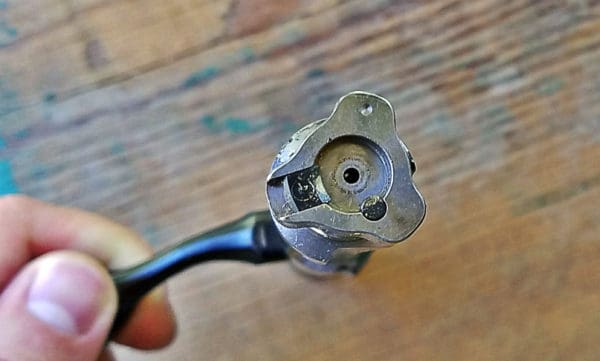
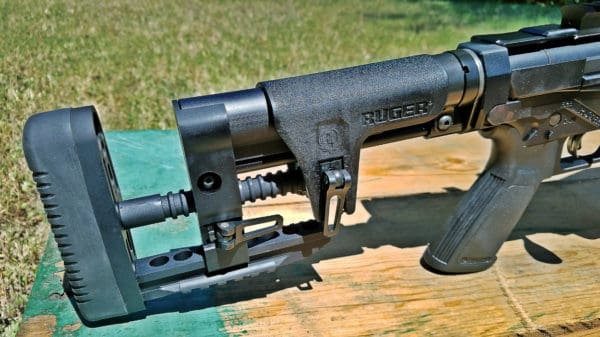



These things are just awesome. I’m gonna have to pick one up. Still think I’m leaning toward the 6.5, but options are never a bad thing.
“I’m gonna have to pick one up. Still think I’m leaning toward the 6.5, but options are never a bad thing.”
I’m leaning towards the 6.5 as well, but I’m waiting to hear the update from Tom in Oregon on how his turned out after it had to be returned to Ruger.
Then I’m hoping someone will step up with an article on the specifics-strategies on working up precision loads, and have the patience to answer a bunch of brain-damaged ‘noob’ questions from morons like myself…
Honestly, my overall interest in reloading for precision has gone down over the last couple years as increasingly better factory ammo becomes even more available. We’re talking super high BC, secant and hybrid ogive projectiles loaded nice and long so they’re dang close to the rifling when chambered and loaded so consistently that most handloaders have a hard time doing it that well. For instance, Federal’s Gold Medal Berger load. I ran a bunch over a chrony and so did [former TTAG writer] Tyler, and we both ended up with standard deviations around 8 to 9 fps. Tyler put 9 of those rounds into a single 0.497″ group at 100 yards, shot a 0.132″, 5-round group, and shot a handful of other 5-round groups at or under a half minute. Federal’s Edge TLR, Hornady’s various ELD and VLD loads, and plenty of ammo from other brands like Gorilla and Winchester and Eagle Eye and IMI and Barnes and Creedmoor Sports and etc etc etc are ridiculously consistent.
…and the price difference now between these sorts of match loads and making your own match loads is small enough that it takes quite a lot of shooting to make up for the cost of the reloading equipment. Really, I think the best reason to do it yourself is because you want a rewarding hobby, which it is. The financial savings argument is pretty darn thin for me, especially if you’re going to put a price on your time, and unless you’re shooting bullseye competition I’m fairly sure there’s a factory load that’s going to be more than accurate enough. So…do it for the pleasure of it, not for some objective purpose. IMHO.
For 5.56 the RPR at it’s price point is ideal. Any other caliber and you may as well step up to a better quality gun for 6.5 creedmoor or even 308.
I don’t do much hunting. I bought a Savage Axis II in .308 with a wood stock to keep just in case I go. If I ever get deeper into hunting or into long range shooting, this looks like a really reasonable upgrade.
Looks good. Interesting result with M855 ammo, proves even an accurate rifle can’t make up for crap ammo. (it’s not really crap for many purposes, but it is from a precision perspective).
JS – thanks for the review, I’m interested in this 556 setup. I wasn’t aware that Tyler was a “former writer” – did he decide to hang up his own shingle or did RF say adios?
Oh, a bit complicated and not really my place to say. However, I had noticed a handful of comments over the past couple months that mentioned how he hasn’t written anything for a while, and figured I’d just sort of state in my response above that he no longer writes for TTAG. He’s still a very good friend of mine and of most or all of the TTAG crew and he’s a solid and nice dude, so it’s nothing bad or weird or scandalous at all!
Hell – change happens – no worries. No trolling here, just enjoyed his writing and look forward to more of your work!
As i am not really into precision shooting, at least not as far as competition goes, is the 556 used for it?
This just seems like a lot of rifle for a small caliber with little recoil.
I love the rpr, and im putting money aside for onein 308, just curious about it in 556.
No, 5.56 isn’t really used in PRS competition as it gets blown around by the wind too much to be consistent past, oh, 600 yards except in pretty still conditions. It can also be hard to see the impacts on steel since it’s a lightweight, small bullet. However, in matches that don’t get out to particularly long ranges or for just doing it for fun and experience and learning, it would be fine. I’d say the best PRS-related use, though, would be as a trainer! Practice with affordable .223 to nail your fundamentals and get used to shooting from all sorts of weird positions and structures, and when you’re confident and ready to step up your game sell it and switch to something in a more appropriate caliber (which would include an RPR in 6.5 CM). Learning to read the wind and hold for it plus adjust for bullet drop at long range, etc., with .223 would really make you appreciate how much flatter shooting and less affected by the wind something like 6.5 CM or .260 Rem or other calibers are, and probably make you a better shooter for it.
BTW don’t go .308. Go 6.5 Creedmoor. If I may be so bold. If you plan on shooting past 750 yards in particular, you’ll be darn glad you did. Not only do you have to hold about half as much for wind as you do with .308 and deal with a lot less bullet drop, but it stays supersonic to much farther distances and, therefore, maintains accuracy to much farther distances. While cheap .308 is certainly a lot less expensive than 6.5 CM (because there really isn’t “plinker” grade 6.5 CM), the match grade ammo in both calibers is effectively identical in price. If you’re getting an RPR and using it to shoot tiny groups or shoot long ranges, etc., you aren’t going to be using cheap crappy ammo that’s getting you 2.5 MOA anyway. So the price difference ends up a wash. But your hit percentage if, for instance, you estimate your wind hold is 2.1 MOA with 6.5 but 3.6 MOA with .308 is not a wash. You’ll be on target significantly more often with 6.5. Plus it shoots much softer, which makes practice more pleasant and makes spotting your own shots a lot easier.
At last a person who’s talking sense, learn to shoot with these cheap to run cartridges then when your competent move up to some thing which will be suitable for all types of game and target shooting.
Ruger needs to offer a Ruger Precision Rifle in 300 Win Mag.
Because it’s still 1990 ?
Options are always great for the consumer. I like what ruger is doing but right now Mossberg is king of the bang for your buck title. Imo.
WANT!
How does Ruger keep producing rifles I want to own and use?
$1,599?!? I spent that much on my 20″ Ar long range gun which.. isn’t… as.. accurate. Damn. Huh. It also weighs 3lb more. Alright- Seems like a good deal to me!
…well it’s available for not much over $1,100. Ruger products typically retail for appreciably less than the full MSRP number.
Mmmmmmm. OK.
My custom home-built suppressed 5.56 NATO AR.
Which cost me around $800 including the Form 1 suppressor but not the $200 Tax Stamp.
Bench with bipod for front support only.
http://i1248.photobucket.com/albums/hh500/AF_Veteran/SN854446_zpskb2upy9o.jpg
http://i1248.photobucket.com/albums/hh500/AF_Veteran/6-2-2017%20Target%201-1_zpsymxkvskg.jpg
That’s awesome! Crazy impressive for any AR-15, really regardless of price point and such.
…don’t forget, though, 3-round groups aren’t 5-round groups…
Thanks for the review! I was just wondering; does Ruger send you a rifle for review or do you guys get a random one from a gunshop?
Review guns in general are either borrowed from a gun shop or other dealer/distributor, borrowed from an owner, or borrowed from the manufacturer. In this specific case, the RPR was loaned to us by Ruger.
I’m one of those guys who purchased the new RPR chambered in 5.56 NATO to get into target shooting and have found it to be a great Rifle (have not shot its yet). I purchase my brand new RPR .223/5.56 included scope rings, sling, extra picatinny rail for bipod install and tread protector if you choose to take off the hybrid muzzle brake. For the price I could not pass it up $850.00. The prices have come way down on all of the RPR offerings. I will admit in the excitement I for got about the main accessory “a good optic”. I am finding the cost of a quality optic to be more then the RPR. Also finding very limited info as to what power scope to put on a .223/5.56 (chambered in 5.56) to get the most out of the rifle without exceeding the capability off this rifle. I was looking at (example) Nikon Black FX1000 4-16×50 FX-MOA or something in this ball park. So if any of you folks have any experience or good advise I would really appreciate it.
I got mine for $750 and put on a 6X24X50 Lucid. I like Vortex glass and reticles better and may swap to higher magnification. That Sig Optics Tango 5x50x56 would be sweet!
5×30 magnification
Does it use regular AR15 mags?
HOW CAN I BUY ONE OF THESE PRECISION RIFLES IN 5.56 AND HOW MUCH
They only sold this short-action version for about a year, which was a pity. I am not sure I see the point of something like the RPR in 5.56mm. It’s much too heavy for its cartridge. But in 6.5 Grendel, on the other hand, assuming the same accuracy could be obtained, it could have utility not just for punching paper at extended ranges–and make better use of the platform’s inherent accuracy with a cartridge better suited to bucking the wind at long range with 123-125 grain high ballistic coefficient bullets. It also would lend itself to hunting creatures larger than groundhogs at distances past 100-150 meters, or “tactical” applications if that’s something that interests you. Then again, for the same weight you could go up to .308, but Grendel ammunition is lighter, allowing the designated rifleman to carry more of it, if that matters to you.
Gear up as your favorite Delsin Rowe Vest. Slim Fit Leather Jackets brings this iconic jacket from animation to reality, especially for all the fans of this video game. Delsin Rowe is the main protagonist and playable character, a young Native-American man who later realizes he’s a Conduit with special powers.